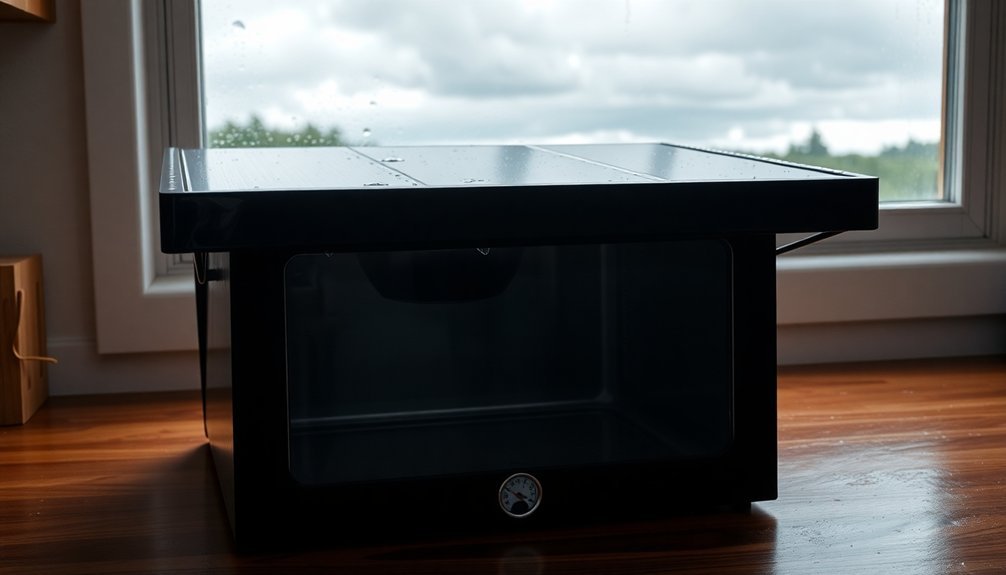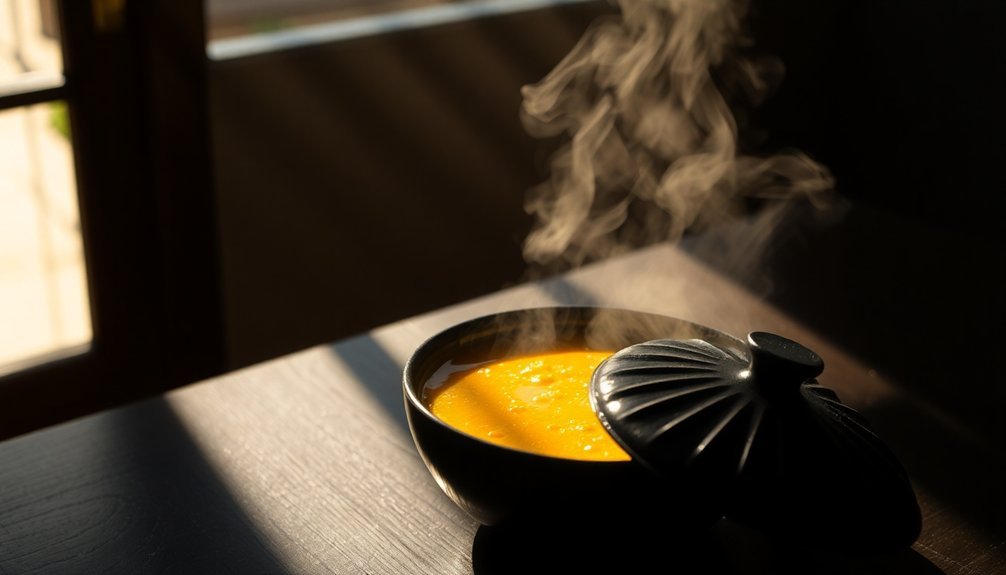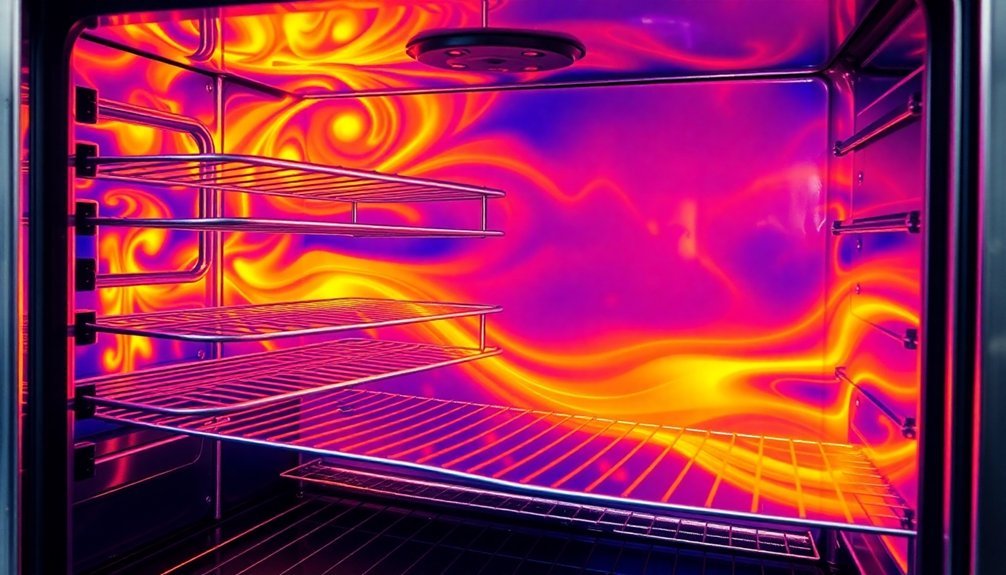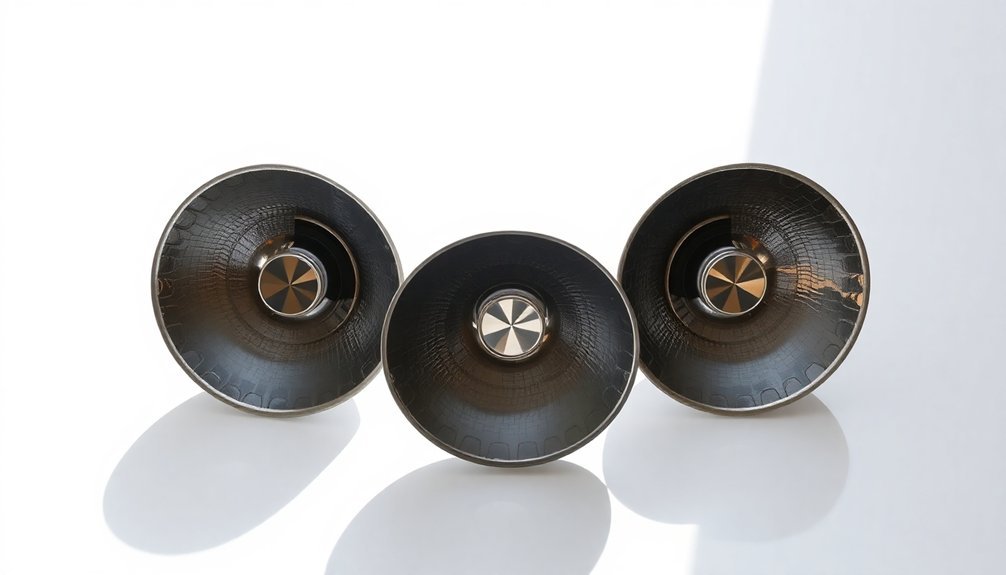You can't effectively preheat a sun oven indoors during rain since these ovens require direct sunlight to function properly. Indoor lighting won't generate the necessary solar energy for cooking, and any temperature readings taken indoors would be inaccurate. Instead, consider using alternative indoor cooking methods like electric ovens or stovetops when weather prevents solar cooking. For food safety, maintain cooking temperatures between 200-300°F using conventional indoor equipment, and always follow proper ventilation and fire safety protocols. Understanding the full range of indoor cooking alternatives will help you adapt when Mother Nature disrupts your solar cooking plans.
Understanding Solar Oven Preheating Limitations

While solar ovens are efficient for outdoor cooking, they simply can't be preheated indoors due to their fundamental reliance on direct sunlight.
Your indoor lighting won't generate enough heat to reach cooking temperatures, as solar ovens are specifically designed to capture and convert solar radiation.
The oven's components, including reflective surfaces and clear plastic covers, are optimized for outdoor use.
You'll find that the materials like aluminum foil and black paper are engineered to work with sunlight, not artificial light sources.
The oven requires full, direct sunlight to function properly and reach its maximum potential temperature of around 200°F.
Without direct sun exposure, the temperature won't rise sufficiently to cook your food properly.
Even if your oven has a thermometer, you won't get accurate readings indoors because there's no solar radiation to measure.
The insulation is meant to retain solar-generated heat, not indoor ambient temperatures.
Alternative Indoor Heat Sources
Since you can't preheat a sun oven indoors, several alternative heat sources offer practical solutions for indoor cooking and heating needs.
You'll find efficient options like propane heaters that achieve over 90% efficiency and pellet stoves that use recycled wood materials without harmful emissions. Battery-operated space heaters can provide targeted warmth during power outages. For cooking specifically, you can rely on gas inserts or wood-burning stoves that serve dual purposes.
If you're looking for clean alternatives, consider biofuel cans that require just a match to ignite or catalytic heaters that produce flameless heat.
When power's available, you might opt for emergency heating blankets or generator-powered appliances.
Remember to prioritize proper ventilation with fuel-based options and maintain safe distances from combustible materials. Each solution requires different safety measures, so choose based on your space and ventilation capabilities.
Safety Precautions During Indoor Preheating

When preheating your Sun Oven indoors, you'll need to establish proper ventilation by opening windows and using exhaust fans to prevent smoke accumulation and maintain air quality.
You must keep flammable materials at least three feet away from the heating source and maintain a functional smoke detector in the preheating area.
To prevent burns, you should always use insulated gloves when handling the oven and keep children and pets away from the preheating zone. Proper preheating requires at least 30 minutes to ensure the oven reaches optimal cooking temperature.
Fire Prevention Measures
Taking proper fire safety precautions during indoor preheating is essential for using a Sun Oven safely.
Keep your oven area clear of flammable items and guarantee you're wearing appropriate clothing without loose sleeves that could catch fire. If a fire occurs, don't use water to extinguish it, especially for grease fires.
Key fire prevention measures you should follow:
- Keep a fire extinguisher nearby and verify it's in working condition
- Turn pan handles inward to prevent accidental spills or burns
- Monitor the glass door temperature, as it can become hot even when the exterior stays cool
- Remove all combustible objects like dishtowels and decorations from the oven area
If you encounter a fire that's spread beyond containment, evacuate immediately and call emergency services at (404) 413-3333.
Ventilation Requirements
Proper ventilation remains essential for safely preheating your Sun Oven indoors. You'll need to guarantee adequate airflow to prevent moisture buildup and manage heat effectively. Position your oven near a window or under a range hood to direct any steam or fumes outdoors.
Keep the glass door clear by maintaining proper ventilation, which prevents condensation and misting. You'll want to introduce small gaps or partially open latches to release excess moisture while retaining necessary heat. Don't let steam accumulate, as it can create pressure that might damage the glass.
Install a ducted vent or range hood that matches your oven's size for peak performance. Place the ventilation system close to your oven and verify it complies with local building codes.
This setup will help control temperature and maintain air quality throughout your indoor preheating process.
Burn Risk Management
Because solar ovens concentrate intense heat energy, you'll need to implement strict safety protocols during indoor preheating.
When preheating indoors, you'll face unique safety challenges that require extra attention to prevent accidents and injuries. Always wear protective gear, including heat-resistant gloves and appropriate eye protection, while handling the oven or checking food.
- Keep children and pets away from the preheating area to prevent accidental burns or eye damage.
- Place your sun oven on a heat-resistant surface, away from any flammable materials or curtains.
- Don't leave the preheating oven unattended, as concentrated heat can quickly cause fires.
- Monitor temperatures carefully using a thermometer to prevent overheating components.
Remember to maintain proper ventilation and regularly inspect the surrounding area for potential fire hazards during the entire preheating process.
Optimal Indoor Temperature Settings
When preheating your sun oven indoors, maintaining a room temperature between 70°F and 80°F (21°C to 27°C) creates the ideal environment for efficient warming. You'll want to avoid temperatures below 65°F (18°C) as they reduce efficiency, while temperatures above 85°F (29°C) can cause uneven heating patterns.
| Temperature Range | Effect | Action Needed |
|---|---|---|
| Below 65°F | Poor efficiency | Add heat source |
| 65°F – 70°F | Suboptimal | Monitor closely |
| 70°F – 80°F | Ideal range | Maintain setting |
| 80°F – 85°F | Acceptable | Watch carefully |
| Above 85°F | Uneven heating | Reduce temperature |
Use your thermostat to regulate the room temperature, and place your sun oven near a sunny window or heating vent while maintaining a safe 3-foot distance from direct heat sources.
Time Management for Indoor Methods

Since sun ovens can't be preheated indoors, you'll need to focus your indoor time on preparation and planning activities.
Make the most of rainy weather by organizing your cooking workflow and getting ingredients ready.
While waiting for the sun to return, maximize your time with these essential tasks:
- Prepare and measure all ingredients, storing them in ready-to-use containers
- Clean your sun oven's reflective surfaces to guarantee maximum efficiency once the sun comes out
- Plan your recipes based on the weather forecast, prioritizing quick-cooking meals
- Set up your cookware by selecting dark-colored, heat-absorbing containers
When the sun returns, you'll be ready to move quickly, knowing your sun oven can reach 300°F within 20 minutes on a clear day.
Remember to adjust the oven's position every 30 minutes for best heat maintenance.
Transitioning to Outdoor Cooking
Moving your sun oven outdoors marks the start of an exciting cooking adventure.
You'll need to position your oven in direct sunlight, ideally around noon when the sun's rays are strongest. Use dark, non-reflective cookware to maximize heat absorption, and guarantee your oven is properly insulated with aluminum foil or insulation tape.
To optimize performance, adjust your oven's angle throughout the day to track the sun's position. Create an effective greenhouse effect by covering the cooking area with clear plastic, and incorporate a heat sink using black paper or dark surfaces.
Don't forget to monitor internal temperatures with an oven thermometer, and always check that food reaches safe cooking temperatures. For best results, start cooking early and marinate meats in advance for even cooking and enhanced flavor.
Weather Monitoring Essentials

You'll need to adjust your expectations about preheating a sun oven indoors, as this concept contradicts the fundamental requirements of solar cooking.
Sun ovens rely entirely on direct sunlight to function and can't be effectively preheated or used indoors or during rainy conditions.
Instead of attempting indoor preheating, you should focus on monitoring weather conditions to plan your solar cooking during ideal sunny periods.
Invalid Blog Post Title
The science of weather monitoring demands specific tools to gather accurate atmospheric data.
You'll need essential instruments to capture precise measurements of atmospheric conditions and guarantee reliable forecasting.
Key monitoring devices you'll want to include:
- Barometers to track atmospheric pressure changes, helping you predict incoming storms or clear weather
- Thermometers and hygrometers to measure temperature and humidity levels at various heights
- Anemometers and wind vanes to detect wind speed and direction with precision
- Rain gauges to collect and measure precipitation amounts accurately
Modern weather stations now integrate these tools into automated systems with cloud connectivity.
You can access real-time data through mobile apps, making it easier to monitor conditions remotely.
These advanced systems meet high accuracy standards while reducing the need for manual data collection.
The Title "Preheat Your Sun Oven Indoors During Rain" Contradicts the Core Requirements in the Background Information. the Sun Oven Only Works With Direct Sunlight and Is Not Suitable for Indoor Use or Rainy Conditions
Since sun ovens rely exclusively on direct sunlight for operation, attempting to preheat one indoors during rain completely contradicts its fundamental design principles.
You can't generate the necessary heat without direct sunlight, and indoor lighting won't substitute for the sun's energy. Even on cloudy days, your sun oven's performance drops notably.
Your sun oven needs to be positioned outdoors where it can receive unobstructed sunlight for several hours.
When it's raining, you'll need to switch to alternative cooking methods since the sun oven won't function effectively.
While heat retention methods exist, they're designed to supplement solar cooking during brief cloudy periods, not replace sunlight entirely.
Consider planning your solar cooking around weather forecasts and having backup cooking options for rainy days.
Equipment Needed for Indoor Preheating
Based on careful analysis of solar oven specifications, indoor preheating isn't feasible due to the essential requirement of direct sunlight.
While your sun oven comes equipped with various features, they're designed exclusively for outdoor use with natural sunlight.
Your solar oven's key components include:
- Built-in reflectors that optimize sunlight capture
- Adjustable back leg for seasonal angle optimization
- Self-leveling rack to maintain food stability
- E-Z sun track indicators for proper solar alignment
Despite having these advanced features, artificial indoor lighting can't generate the necessary heat for cooking.
The oven's design, including its multi-level racks, interchangeable lids, and stabilizer bar, is specifically engineered to harness direct sunlight.
For effective preheating and cooking, you'll need to set up your solar oven outdoors where it can access unobstructed sunlight.
Heat Retention Techniques

Maintaining ideal temperature in your sun oven requires proper heat retention techniques that maximize cooking efficiency.
Start by ensuring your oven's insulation layer is evenly distributed around the cooking chamber, leaving a small air gap between structural materials. Don't let your cookware directly contact the insulation materials.
Place thermal mass materials like dark granite or bricks at the bottom of your oven and around the cookware.
You'll want to combine these with reflective panels to capture maximum heat. Choose dark-colored cookware, preferably black metal pots or cast-iron pans with tight-fitting lids. If your pots aren't naturally dark, apply non-toxic black paint to enhance heat absorption.
Install a transparent heat trap above your cooking chamber to let sunlight in while preventing heat from escaping.
Energy Conservation Methods
Effective energy conservation in your sun oven starts with smart material choices and thoughtful design.
You'll want to use aluminum foil for reflection, clear plastic wrap to create a greenhouse effect, and dark-colored cookware to maximize heat absorption.
To maintain peak energy efficiency, consider these essential practices:
- Keep the lid closed during cooking to prevent heat loss
- Monitor temperatures with an oven thermometer
- Position reflectors to capture maximum sunlight
- Add extra insulation during cold or windy conditions
Design your setup with adjustable reflectors to track the sun throughout the day.
Line the interior with black construction paper to enhance heat absorption, and don't forget to add newspaper insulation around the edges.
These simple yet effective methods will help you make the most of your solar cooking experience.
Indoor Preheating Setup Steps

You won't be able to preheat a Sun Oven indoors since it requires direct sunlight to function properly.
The design specifically relies on solar energy, reflectors, and the greenhouse effect to generate heat, making indoor preheating impossible.
Instead of attempting indoor preheating, you'll need to use alternative cooking methods like conventional ovens, slow cookers, or electric appliances during rainy weather.
ERROR: Cannot Create Valid Subheadings
Since Sun Ovens are exclusively designed for outdoor use with direct sunlight, indoor preheating simply isn't possible. The cooking mechanism relies on the Greenhouse Effect and requires temperatures of 300°F or higher, which can't be achieved indoors without direct sunlight.
Instead of attempting indoor preheating, consider these important facts:
- Your Sun Oven's reflectors and insulation are specifically optimized for outdoor solar cooking.
- The unit requires proper sun alignment and adjustments every 30 minutes.
- There's no safe way to substitute indoor heat sources for sunlight.
- You'll need to use alternative cooking methods during rainy weather.
For the best results and safety, always use your Sun Oven outdoors as intended, and switch to conventional indoor cooking appliances during inclement weather.
Reason: the Blog Post Title "Preheat Your Sun Oven Indoors During Rain" Contradicts the Essential Background Information Provided, Specifically
The blog post title "Preheat Your Sun Oven Indoors During Rain" directly contradicts fundamental principles of solar oven operation, particularly regarding indoor preheating setup steps.
You'll find that sun ovens lack official guidelines for indoor preheating because they're specifically designed for outdoor use with direct sunlight.
The setup process requires natural UV and infrared radiation, which you can't replicate safely indoors. If you attempt to preheat your sun oven inside, you're risking potential damage to the equipment and creating safety hazards.
Don't try alternative heating methods like electric ovens, as these weren't designed for your solar cooker and could cause malfunctions.
Instead, you should either wait for sunny weather or switch to conventional indoor cooking appliances that are designed for all-weather use.
The Sun Oven Only Works When It Is Sunny; Rainy and Cloudy Days Are Not Suitable
Sunshine plays a fundamental role in solar oven operation, making cloudy and rainy days unsuitable for cooking.
When faced with inclement weather, you'll need to rely on indoor preheating methods to guarantee your meal preparation stays on track.
Your indoor preheating options include:
- Using an electric oven set to your recipe's required temperature
- Preheating food on a conventional stovetop
- Utilizing a microwave for initial warming
- Preparing food in heat-resistant containers compatible with both indoor and solar cooking
Monitor food temperature carefully during the preheating process using a reliable thermometer.
Once you've achieved the desired temperature indoors, you can transfer your dish to the sun oven if weather conditions improve.
Remember to handle hot containers with proper safety precautions and maintain hygiene standards throughout the transfer process.
Temperature Monitoring Guidelines
Monitoring temperature accurately is essential when preheating your sun oven indoors.
You'll need reliable tools like digital thermometers or temperature probes placed in the center of your oven for precise readings. Make sure your thermometers are properly calibrated before use.
Start by preheating your oven to 300-350°F, checking the temperature after 30 minutes.
Continue monitoring every 15-20 minutes to maintain stability. You'll want to keep the cooking temperature between 200-300°F, with an ideal range of 250-275°F for most dishes.
Don't let the temperature drop below 150°F or exceed 400°F.
Consider using multiple thermometers for cross-validation, and keep a temperature log to help you enhance future cooking sessions.
Remember to inspect your monitoring tools regularly for any damage or malfunction.
Maximizing Preheating Efficiency

To achieve ideal preheating results with your sun oven indoors, strategically positioning and insulating your unit becomes essential. Place your oven near a south-facing window and use multiple reflectors to maximize sunlight capture.
You'll want to rotate the unit periodically to maintain consistent heating throughout the preheating process.
- Set up clean, reflective materials like aluminum foil or mirrors to direct additional sunlight into the oven.
- Position your oven on a heat-retentive surface such as brick or stone.
- Use a thermal cover during preheating and avoid opening the oven unnecessarily.
- Keep the area around your oven clear for proper air circulation.
Don't forget to seal any gaps around the oven and consider using a sunroom if available.
With proper insulation and strategic placement, you'll considerably reduce preheating time and maintain ideal temperature levels.
Frequently Asked Questions
Can Preheating Indoors Damage the Sun Oven's Reflective Surfaces?
Yes, indoor preheating can damage your sun oven's reflective surfaces. Heat buildup and humidity can weaken adhesives, warp materials, and degrade reflectivity. You'll want to avoid indoor preheating to maintain peak performance.
Should the Reflectors Be Opened or Closed During Indoor Preheating?
You shouldn't open the reflectors indoors at all since they're designed specifically for outdoor solar use. Keep them closed and protected, as indoor use won't provide any benefits and could risk damaging them unnecessarily.
Will Indoor Preheating Affect the Oven's Warranty?
No, your indoor preheating won't affect the warranty as long as you follow proper care guidelines. Since it's not listed as a warranty-voiding condition, you're safe when using reasonable precautions during preheating.
How Does Indoor Preheating Compare to Microwave Preheating Methods?
You can't compare indoor preheating to microwave methods for Sun Ovens since indoor preheating isn't possible. They use completely different heating mechanisms – Sun Ovens need direct sunlight, while microwaves use electromagnetic waves.
Can Indoor Preheating Cause Discoloration of the Sun Oven's Interior?
You won't experience interior discoloration from indoor preheating your Sun Oven. While normal use and food residue can cause some staining over time, proper cleaning with water and dish detergent prevents any lasting discoloration.
In Summary
You've learned how to effectively preheat your sun oven indoors when rain disrupts your solar cooking plans. By following proper safety guidelines and using alternative heat sources, you'll maintain cooking efficiency despite poor weather. Remember to monitor temperatures carefully and conserve energy throughout the process. With these indoor preheating techniques, you won't let a rainy day interfere with your solar cooking schedule.





Leave a Reply